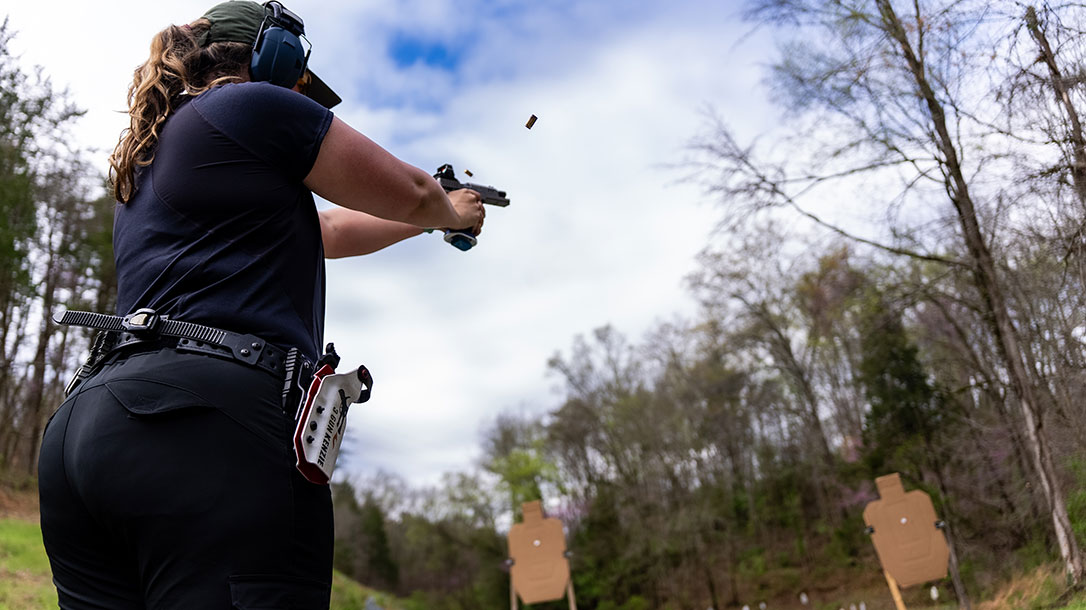One of the “AHA!” moments in my shooting journey was realizing that time isn’t lost as much when you’re shooting at a target but in the transitions from one target to the next. In competition shooting, the ability to swiftly transition between targets is crucial, as nearly all stages feature multiple targets. This drill focuses on one goal: improving how quickly you can transition from one target to the next.
Target Transitions Drill: Tools Needed
- Pistol of Choice (Nighthawk BDS9 with Holosun 507Comp)
- Shot Timer (Kestrel KST1000)
- Ammunition
- Two Targets (USPSA, GSSF, IDPA, shooter’s choice)

The Drill
This drill requires two targets set up at about 2-3 yards apart. Using a shot timer, the goal is to transition from Target A to Target B as quickly as possible and fire one shot. You are not shooting at Target A. However, you are aiming and looking at that target at the start of the beep.
Advertisement — Continue Reading Below

This drill should be shot from left to right and right to left to work on moving in both directions. I highly recommend putting a white paster on both targets where you want your shot to impact.
If you’re working on this by yourself, set a delayed start on your timer to accurately track your times.
Advertisement — Continue Reading Below
Eyes Lead, and the Gun Follows

The point of this drill is to get your eyes moving and have your gun follow to your next target. The biggest mistake newer shooters make when shooting multiple targets is moving their gun to find the next target before their head or eyes move. This is slow and inefficient.
The white paster on Target B is where your eyes should immediately snap to when the timer beeps. Your gun will follow your eyes, and your sights should align on target, focusing on impacting on or near the white paster.
Advertisement — Continue Reading Below
Assess Your Target

You should aim for a mix of speed and accuracy. This drill is not meant to stop on Target B, perfectly align your sights, and then fire the shot. The goal is to move your gun as fast as possible. When you see your sights coming across or near the white paster, fire your shot.
If your target has a perfect grouping, you’re not doing this drill right. You should be pushing speed and either shooting too soon or overrunning your shot and shooting to the right of the white paster.
Advertisement — Continue Reading Below
Time Tracking, Goal Setting, and Dry Fire

As with any shooting drill, you should always track your times. Run the drill a dozen times to find your most consistent/average transition time from Target A to B, and fire a shot. Once you have this average time, set a goal to reach a faster time while maintaining some sense of accuracy.
Dry firing this exact drill at home with an unloaded and empty firearm will improve your shooting tenfold. I know competitive shooters who rarely have time to get to a range to practice with live ammunition. So, they dry fire daily and consistently place high at matches.
Advertisement — Continue Reading Below
For dry fire, I recommend setting a par time that pushes you to run this drill consistently but quickly and accurately.
Making Progress
As you get better with this drill, mix in harder target presentations. For example, no-shoot or non-threat targets, partial targets, or just more targets in general. If you’re more of an advanced-level shooter, you should work on prepping your trigger in between targets. This way, when your sights come across your intended target zone, you’re ready to fire the shot.
For competition shooters, dry fire is where most progress is made. Live fire is more of a confirmation of what you’ve been doing at home in dry fire practice. Keep working towards small goals, and you’ll notice how much it pays off when it comes time to compete.
Advertisement — Continue Reading Below

























